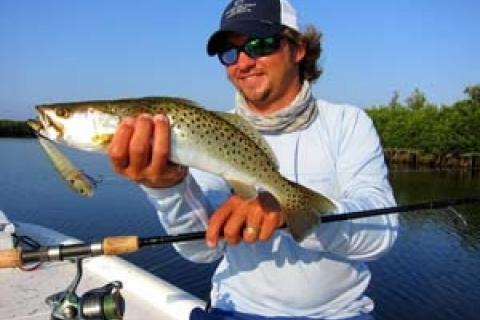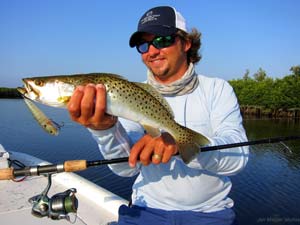
Captain Benny Blanco piloted his sleek Maverick flats skiff across the green expanses of Florida Bay and slowed down at the "entrance" to Snake Bight. He then cut the engine, tilted it up, and grabbed his pushpole as he climbed the over-the-motor tower. It was May and the unfolding warm weather had put the spotted seatrout into the shallows purportedly in the hundreds. As Benny poled into the depths of the bight and onto the crown of the huge flat, he discussed the unique tackle, conditions and plugs we'd soon be involved with — and it bears repeating.
 |
| Captain Benny Blanco took this big seatrout on a popping topwater plug. |
Basics of Topwater Trout Tackle
The key to getting quality spotted seatrout are long casts to fish that are unalarmed or un-alerted to the presence of the poled skiff, kayak, paddleboard or even waders. Vessels and wading anglers all give off a pressure wave detected through the lateral lines of seatrout. Couple this with the trout seeing a moving vessel, casting rod movements, or human silhouettes and you'll have "spotsides" with a big case of lockjaw.
Your best chances of distance casts — all things being equal — is by using braided line coupled with a good quality graphite rod. Given all the challenges of wind and weather from the Carolinas to Texas, spinning tackle casts further than revolving spool "plug" tackle for most average anglers. Many anglers endorse regular monofilament for close-in bait fishing since this type of line is the most "forgiving" with its greater stretch to minimize the soft-mouthed trout's tear-outs, but casting topwater plugs to seatrout is another story.
Here's why braided line is just the item you'll need: Braid is thinner than the equivalent pound test mono and therefore yields longer casts. It is not necessary to use anything heavier than 10-pound braid, which is equivalent to 2-pound test mono. Imagine the distance of your casts with a good-sized topwater on the business end of your line!
Braided line has extremely low stretch, which translates into two great advantages: Firstly, combined with the stiff sensitivity of a sweeping graphite rod, braided line enables the angler to "dance" the plug or "walk the dog" with an ease never experienced before. In addition, when it's necessary to sink the relatively thicker treble hooks of the plug itself, the low stretch of braided line converts to more hookups. Most importantly, strike detection with braided line is easier than with plain mono. It is essential to remember with topwater plugs is that you will see many explosions on your plug with spotted seatrout — do NOT strike the fish until you feel the weight after it has actually grabbed the plug and is heading back down into the water.
Topwater Plugging Weather
There is an intimate relationship between ideal seatrout weather and the use of topwater plugs. Spotsides often favor low light conditions with a bit of breeze. These times are typified by evenings, dawn, dusk and cloudy days with a small amount of wind scuff at the surface. Trout are least likely to strike a surface plug during the bright heat of flat-calm midday, though there are exceptions to this. Benny theorized — as do many anglers — that striking upward into a bright sun is less likely as the trout cannot get a good look at the offering they are striking. And, yet, there are days — as ours would be — that the trout smash topwaters all day long. But again, this is more likely to occur in the lower temperature days of spring and fall rather than the hot days of deep summer. Complicating the weather parameters is the specific locale. In coastal Texas, many trophy spotted seatrout have been taken on blustery winter days. Therefore, it pays to do research on the area you'll be doing your topwater fishing.
Conversely, during cold winter days — like in Florida — when the trout go deep into channels and drop-offs, fishing with topwater plugs is less productive with the exception of casting to larger gator trout sunning themselves in the shallows in warmer winter afternoons. Even then, the winter trout metabolism makes it less likely that they'll strike a topwater in very cold water.
Topwater Plugs
 |
| Captain Kyle Messier looks happy with this nice seatrout taken on a dancing topwater plug. |
There are generally three types of topwaters: poppers, "Zara-type" dancing plugs and prop-outfitted "swish" plugs. All of these plugs are worked with rod action, but have different kinds of appeal. As should be obvious, poppers make a chugging noise just like their popular cousins, the popping corks. Popping plugs can be briefly paused at the surface between pops. Dancing plugs — originally embodied in the Zara Spook prototype — need constant rod sweeps to keep the plug dancing from side to side for the best presentation. "Swish" plugs fitted with fore and aft propellers make a unique surface disturbance that trout love. This latter plug can also be stopped briefly between rod sweeps. The two cardinal rules for all plugs are to hit the fish when you feel the weight of its body-not the strike itself- and also to keep grass off the treble hooks.
Most plugs are made of extremely hard plastic and loaded with sharp hooks, so trout will generally turn away after striking this un-natural feeling object. This would be in contrast to trout second-striking a fleshier, soft plastic bait, like a D.O.A. Baitbuster. The object, then would be to create enough sensation, effect or factor to cause the trout to hit the topwater plug after it has missed a strike. One way to do this is by using a "soft" plug. This is embodied in the classic Texas-based popular Corky lure, which is made and marketed by MirrOlure as the Paul Brown Original Series. Many anglers up the odds for stronger and more repeated strikes by adding some attractant/bait scent to a soft plug. Parenthetically, if you're using a soft, scented, topwater in the presence of big mullet schools in some good Texas trout water, your chances of a trophy trout have grown considerably.
Time for Action
Benny had finally poled well into the bight for a distance of a few hundred yards. The southeast wind created enough of a breeze for the skiff to make a nice drift into the bight as we simultaneously fished. As Benny climbed down from the tower and racked his pushpole, he told me that our tactic would be making long downwind casts that would initially be focused on sandy potholes, which were known ambush lairs for Spotsides. Seeing those potholes would be easier with a good pair of polarized sunglasses and dark amber was the color I chose for either cloudy or open sky sunlight for this particular area.
 |
| A seatrout's fang enables it to grab a topwater plug and hold on. |
He then took out two spinning outfits that were racked in the under gunwale horizontal rod holders. Both outfits were spooled with 10-pound braided line that was attached to a 2-foot length of 30-pound fluorocrbon leader. He then rigged one popping plug to one spinner and a "Zara"- style dancing plug to the other. Both of the artificials were fastened to the leader with a loop knot. Both of us were glad that the conditions did not foul the water surface with floating grass, which certainly would have hurt out topwater efforts.
We both began firing casts downwind as far as we could to the potholes that dotted the flat. Seeing them was easy as they appeared as yellow ovoid shapes amidst the green pastures of turtle grass. Benny chose the dancing plug and he retrieved the lure with upward sweeps of the rod tip as he danced the plug across the 2-foot deep flats. He groaned and I watched as his rod heeled over under the weight of a good strike. In the distance, I could see a big trout thrashing on the surface. I cast my popper to the area where Benny had the strike and within two sweeps of my rod, my plug was struck in a geyser of green water. Though my line was without slack, I waited for it to tighten, signaling a solid "eat." That happened within a second and I, too, was solidly hooked up.
Both of us brought in fish of around 3-4 pounds, which are big trout for this region.
We repeated the same drill again and again, hooking fish and releasing them in double-header fashion. Soon, we did not have to cast to potholes. It seemed that any long downwind cast would be blasted on the surface. My guess was that the combined sounds of both our plugs as well as the surface strikes got the trout into an increasingly aggressive mood.
We both realized that topwater plugs often embody the sight fisherman's dream of a visible "take" or "eat," as some anglers put it. And with edible species like spotted seatrout, we spent a grateful day of sport and an anticipation that if we chose to, fried trout could grace our dinner plates at some point. These are choices any marine angler loves!
- 16097 views

